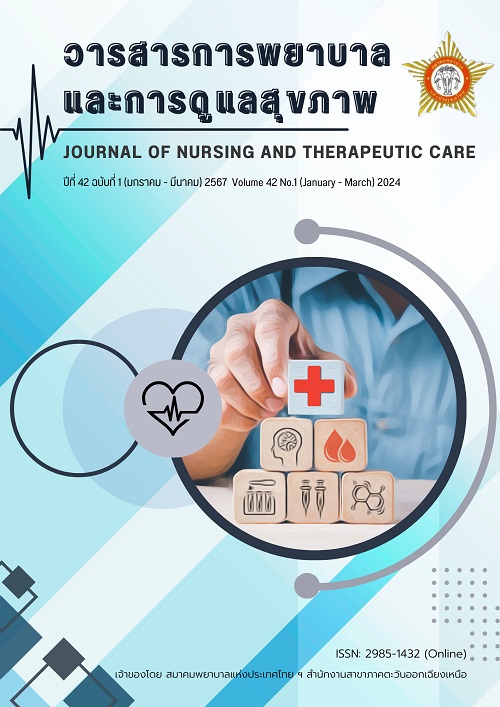ความเสี่ยงทางคลินิกและบทบาทพยาบาลในการดูแลผู้ป่วยสูงอายุหลังผ่าตัดเปลี่ยนข้อเข่าเทียมระยะฟื้นตัวเร็ว
คำสำคัญ:
ความเสี่ยงทางคลินิก , บทบาทพยาบาล, ผู้ป่วยสูงอายุ, ผ่าตัดเปลี่ยนข้อเข่าเทียม, ระยะฟื้นตัวเร็วบทคัดย่อ
โรคข้อเข่าเสื่อมในผู้สูงอายุเป็นปัญหาที่สำคัญของหลายประเทศทั่วโลก มีสาเหตุเกิดจากความเสื่อมของกระดูกอ่อนบริเวณผิวข้อเข่าและปัจจัยอื่นร่วมด้วยโดยเฉพาะอย่างยิ่งภาวะน้ำหนักเกินและมีการใช้งานของข้อเข่ามากขึ้น ผู้ป่วยสูงอายุโรคข้อเข่าเสื่อมต้องเข้ารับการผ่าตัดเปลี่ยนข้อเข่าเทียมเมื่อเข้าสู่ระยะที่ไม่สามารถให้การรักษาหรือฟื้นฟูสภาพข้อเข่าได้ด้วยวิธีอื่น ในปัจจุบันการผ่าตัดเปลี่ยนข้อเข่าเทียมเป็นวิธีการรักษาที่มีประสิทธิภาพสูงเนื่องจากช่วยให้ผู้ป่วยมีคุณภาพชีวิตที่ดีขึ้น ซึ่งผู้ป่วยต้องเข้ารับการพักรักษาตัวในโรงพยาบาลด้วยระยะเวลานอนที่สั้นลงเนื่องจากได้มีการประยุกต์แนวปฏิบัติในการส่งเสริมการฟื้นตัวอย่างรวดเร็วหลังผ่าตัดมาใช้ในกระบวนการดูแล ส่งผลให้สามารถฟื้นตัวได้เร็ว ลดอัตราการเกิดภาวะแทรกซ้อนหลังผ่าตัดและลดความเครียด ช่วยให้ผู้ป่วยได้รับการจำหน่ายกลับไปฟื้นฟูสภาพร่างกายที่บ้านอย่างต่อเนื่องโดยไม่มีภาวะแทรกซ้อนเกิดขึ้น
อย่างไรก็ตาม ช่วงเวลาฟื้นตัวเร็วของผู้ป่วยสูงอายุในระยะหลังผ่าตัดเป็นช่วงเวลาที่มีความสำคัญและเปราะบางเนื่องจากเป็นช่วงเวลาเปลี่ยนผ่านที่ผู้ป่วยต้องมีการปรับตัวเป็นอย่างมาก ซึ่งอาจส่งผลให้เกิดความเสี่ยงทางคลินิกหรือภาวะแทรกซ้อนเกิดขึ้นได้ บทความนี้จึงมีวัตถุประสงค์เพื่อสะท้อนแนวคิดและนำเสนอแนวปฏิบัติในการส่งเสริมการฟื้นตัวอย่างรวดเร็วหลังผ่าตัด การทบทวนความเสี่ยงทางคลินิกและภาวะแทรกซ้อนที่อาจเกิดขึ้นได้กับผู้ป่วยสูงอายุหลังการผ่าตัดเปลี่ยนข้อเข่าเทียมในระยะฟื้นตัวเร็วและบทบาทพยาบาลในการดูแลผู้ป่วย ซึ่งการทำความเข้าใจในแนวคิด บทบาท และความสามารถในการจัดการความเสี่ยงทางคลินิกจะช่วยให้ผู้ป่วยสามารถฟื้นตัวและฟื้นฟูสภาพได้อย่างมีประสิทธิภาพ
Downloads
เอกสารอ้างอิง
Coaccioli S, Sarzi – Puttini P, Zis P, Rinonapoli G, Varrassi G. Osteoarthritis: new insight on its pathophysiology. J Clin Med. 2022;11(20):6013.
Cui A, Li H, Wang D, Zhong J, Chen Y, Lu H. Global, regional prevalence, incidence and risk factors of knee osteoarthritis in population – based studies. EClin Med. 2020;29(30):100587.
Madaleno FO, Santos BA, Araujo VL, Oliveira VC, Resende RA. Prevalence of knee osteoarthritis in former athletes: a systematic review with meta-analysis. Braz J Phys Ther. 2018;22(6):437-51.
Matthew S, Ajay P, Neil S. Projected volume of primary total joint arthroplasty in the U.S., 2014 to 2030. J Bone Joint Surg Am. 2018;100(17):1455-60.
Yahaya I, Wright T, Babatunde O, Corp N, Helliwell T, Dikomitis L, et al. Prevalence of osteoarthritis in lower middle- and low-income countries: a systematic review and meta-analysis. Rheumatol Int. 2021;41:1221-31.
Thessingha C, Chaiwong C, Onthaisong C, Intolo S. The prevalence and risk factors of knee osteoarthritis among the eldery in Northeast. Journal of Boromarajonani College of Nursing Surin. 2020;10(1):80-90. (in Thai)
Sharma L. Osteoarthritis of the knee. N ENGL J Med. 2021;384(1):51-9.
Shama L, Hochberg M, Nevitt M, Guermazi A, Roemer F, Crema MD, et al. Knee tissue lesions and prediction of incident knee osteoarthritis over 7 years in a cohort of persons at higher risk. Osteoarthr Cartil. 2017;25(7):1068-75.
Bannuru RR, Osani MC, Vaysbrot EE, Arden NK, Bennell K, Bierma – Zeinstra SMA, et al. OARSI guidelines for the non–surgical management of knee, hip, and polyarticular osteoarthritis. Osteoarthr Cartil. 2019;27(11):1578-89.
Chen PY, Song CY, Yen HY, Lin PC, Chen SR, Lu LH, et al. Impact of tai chi exercise on functional fitness in community-dwelling older adults with mild degenerative knee osteoarthritis: a randomized controlled clinical trial. BMC Geriatrics. 2021;21(449):449.
Canovas F, Dagneaux L. Quality of life after total knee arthroplasty. Orthop Traumatol Surg Res. 2018;104(1):S41-6.
Berend KR, Lombardi AV Jr, Mallory TH. Rapid recovery protocol for peri-operative care of total hip and total knee arthroplasty patients. Surg Technol Int. 2004;13:239-47.
Kehlet H. Fast-track hip and knee arthroplasty. Lancet. 2013;381(9878):1600-2.
Kehlet, H. Multimodal approach to control post-operative pathophysiology and rehabilitation. Br J Anaesth. 1997;78(5):606-17.
Chung MMT, Ng JKF, Ng FY, Chan PK, Chiu KY. Effects of enhanced recovery after surgery practices on postoperative recovery and length of stay after unilateral primary total hip or knee arthroplasty in a private hospital. Hong Kong Med J. 2021;27(6):437-43.
Kaye AD, Urman RD, Cornett EM, Hart BM, Chami A, Gayle JA, et al. Enhanced recovery pathways in orthopedic surgery. J Anaesthesiol Clin Pharmacol. 2019;35(S1):S35-9.
Frassanito L, Vergari A, Nestorini R, Cerulli G, Placella G, Pace V, et al. Enhanced recovery after surgery (ERAS) in hip and knee replacement surgery: description of a multidisciplinary program to improve management of the patients undergoing major orthopedic surgery. Musculoskelet Surg. 2020;104(1):87-92.
Zhao D, Ma XL, Wang WL, Zhang L. Effectiveness evaluation between enhanced recovery after surgery and traditional treatment in unilateral total knee arthroplasty. Chin Med J. 2018;98:519-23.
Jiang HH, Jian XF, Shangguan YF, Qing J, Chen LB. Effects of enhanced recovery after surgery in total knee arthroplasty for patients older than 65 years. J Orthop Surg. 2019;11:229-35.
Ghosh A, Chatterji U. An evidence-based review of enhanced recovery after surgery in total knee replacement surgery. J Perioper Pract. 2019;29(9):281-90.
Wainwright TW, Gill M, McDonald DA, Middleton RG, Reed M, Sahota O, et al. Consensus statement for perioperative care in total hip replacement and total knee replacement surgery: Enhanced Recovery After Surgery (ERAS) Society recommendations. Acta Orthopaedica. 2020;91(1):3-19.
Hirsch KR, Wolfe RR, Ferrando AA. Pre- and post-surgical nutrition for preservation of muscle mass, strength, and functionality following orthopedic surgery. Nutrients. 2021;13(5):1675.
Lo CWT, Tsang WWN, Yan CH, Lord SR, Hill KD, Wong AYL. Risk factors for falls in patients with total hip arthroplasty and total knee arthroplasty: a systemic review and meta-analysis. Osteoarthr Cartil. 2019;27(7):979-93.
Lei YT, Xie JW, Huang Q, Huang W, Pei FX. Benefits of early ambulation within 24 h after total knee arthroplasty: a multicenter retrospective cohort study in China. Mil Med Res. 2021;8(17):1-7.
Warren JA, Sundaram K, Anis HK, Kamath AF, Higuera CA, Piuzzi NS. Have venous thromboembolism rates decreased in total hip and knee arthroplasty? J Arthroplasty. 2020;35(1):259-64.
Jenny JY, Bulaid Y, Boisrenoult P, Bonin N, Henky P, Tracol P, et al. Bleeding and thromboembolism risk of standard antithrombolic prophylaxis after hip or knee replacement within an enhanced recovery program. Orthop Traumatol Surg Res. 2020;106(8):1533-8.
Ng J, Nolla PB, James PJ, Bloch BV. Extensor mechanism failure in total knee arthroplasty. EFORT Open Rev. 2021;6:181-8.
Birch S, Stilling M, Mechlenburg I, Hansen BT. Effectiveness of a physiotherapist delivered cognitive-behavioral patient education for patients who undergoes operation for total knee arthroplasty: a protocol of a randomized controlled trial. BMC Musculoskelet Disord. 2017;18(116):116.
Wang Y, Yang Q, Lin J, Qian W, Jin J, Gao P, et al. Risk factors of postoperative nausea and vomiting after total hip arthroplasty or total knee arthroplasty: a retrospective study. Ann Tranal Med. 2020;8(17):1088.
Cha YH, Lee YK, Won SH, Park JW, Ha YC, Koo KH. Urinary retention after total joint arthroplasty of hip and knee: Systematic review. J Orthop Surg (Hong Kong). 2020;28(1):1-6.
Ma Y, Lu X. Indwelling catheter can increase postoperative urinary tract infection and may not be required in total joint arthroplasty: a meta-analysis of randomized controlled trial. BMC Musculoskelet Disord. 2019;20(11):1-8.
ดาวน์โหลด
เผยแพร่แล้ว
รูปแบบการอ้างอิง
ฉบับ
ประเภทบทความ
สัญญาอนุญาต
ลิขสิทธิ์ (c) 2024 วารสารการพยาบาลและการดูแลสุขภาพ

อนุญาตภายใต้เงื่อนไข Creative Commons Attribution-NonCommercial-NoDerivatives 4.0 International License.



